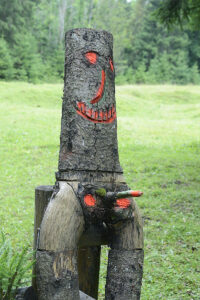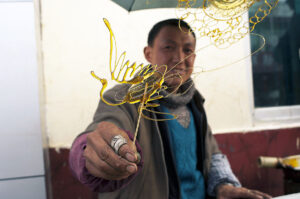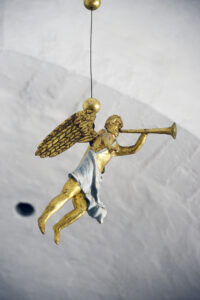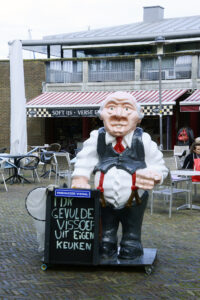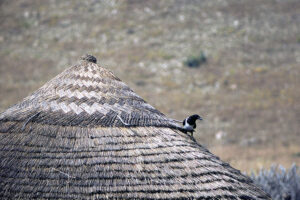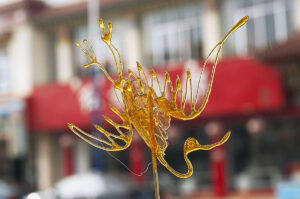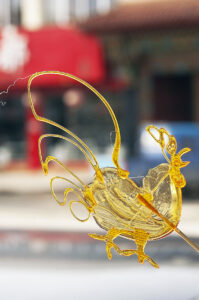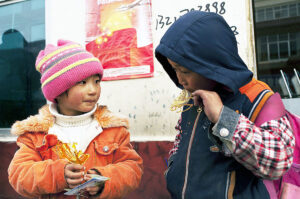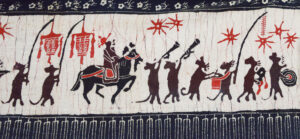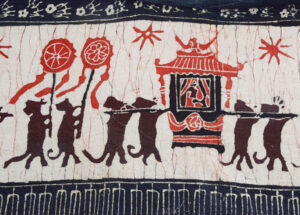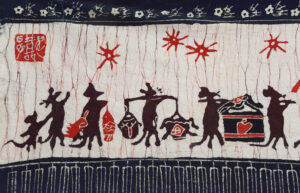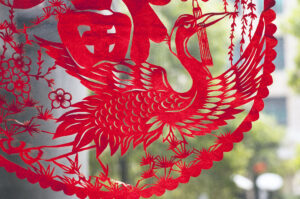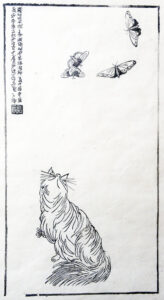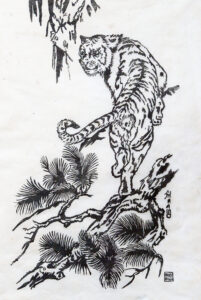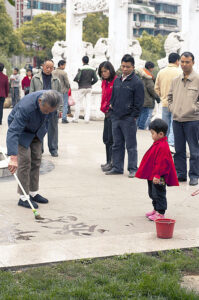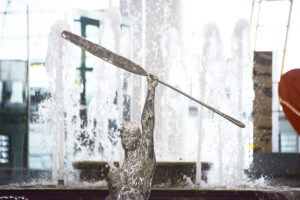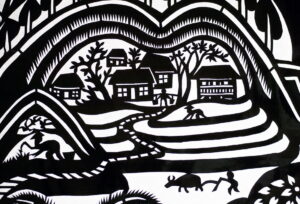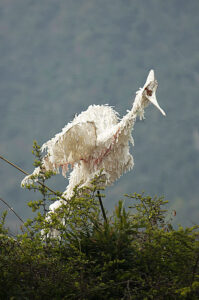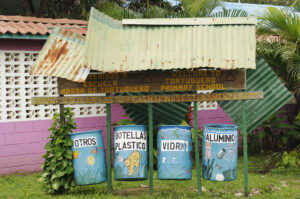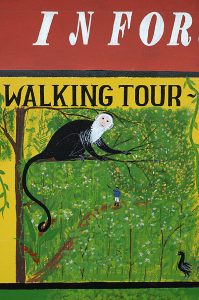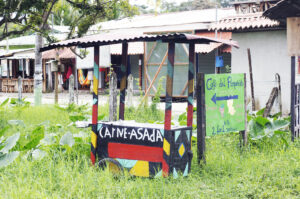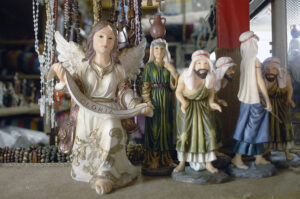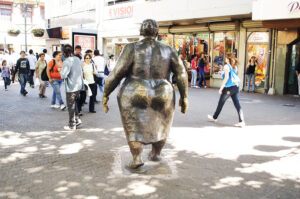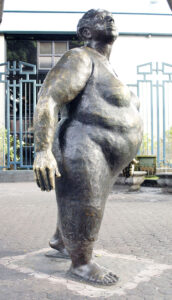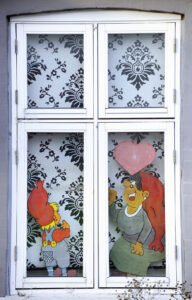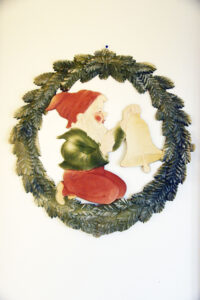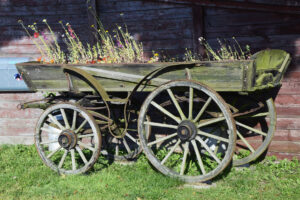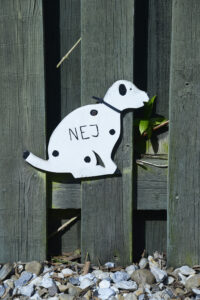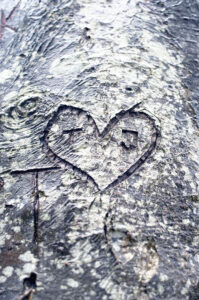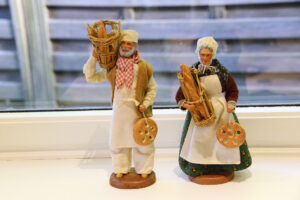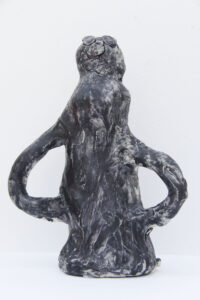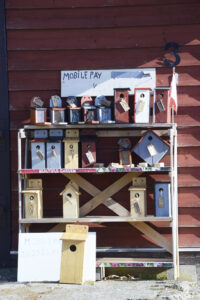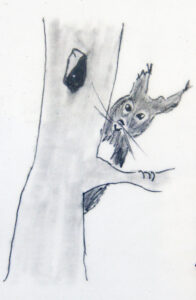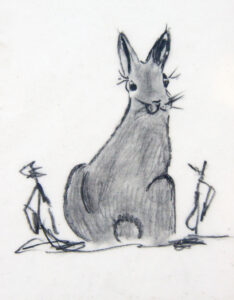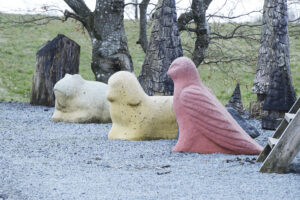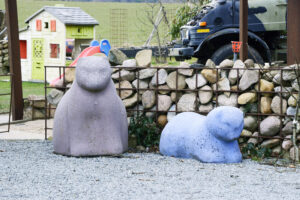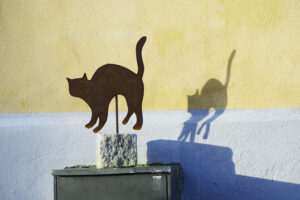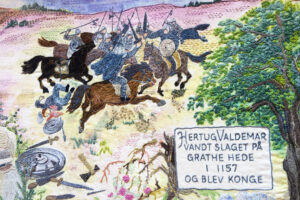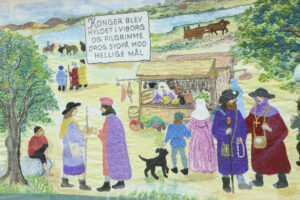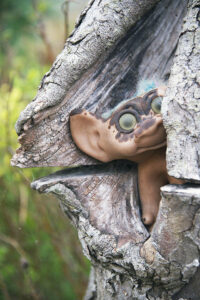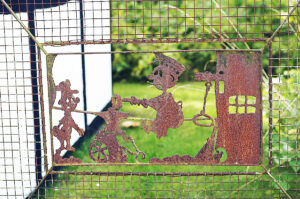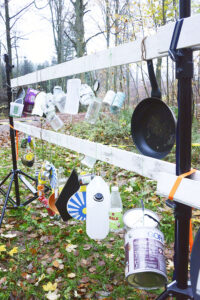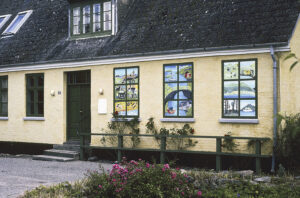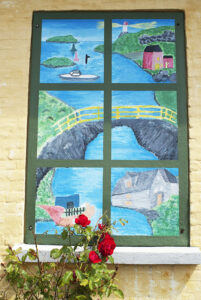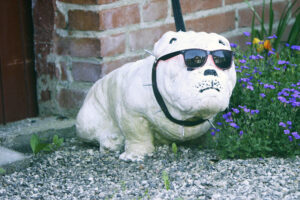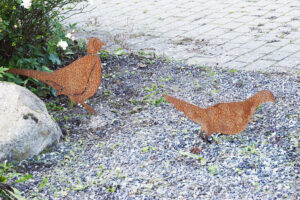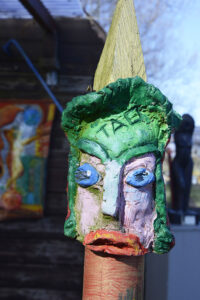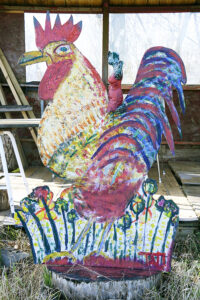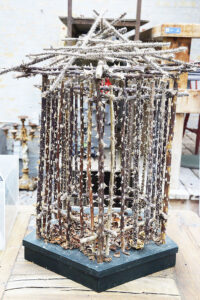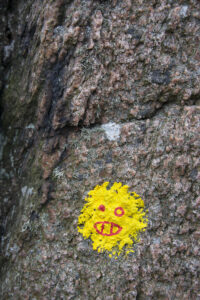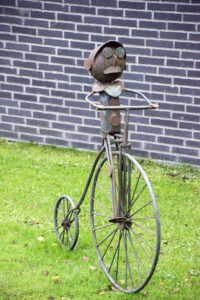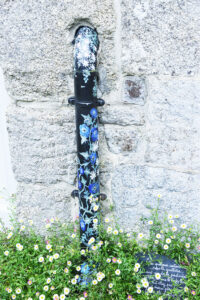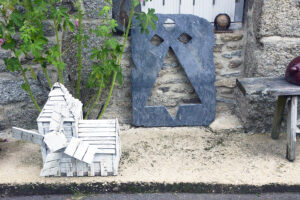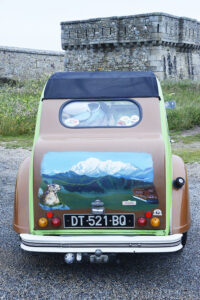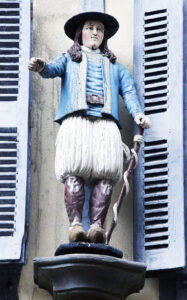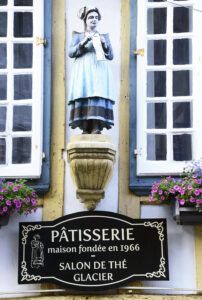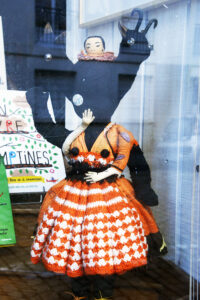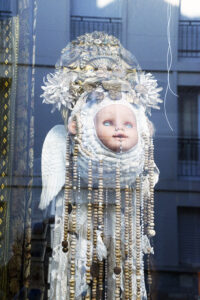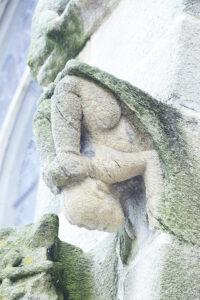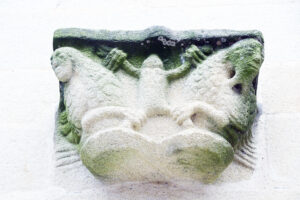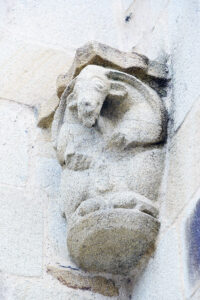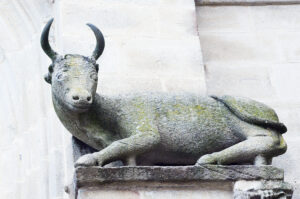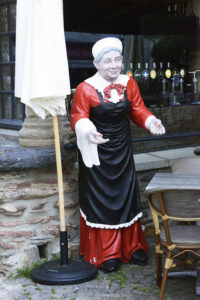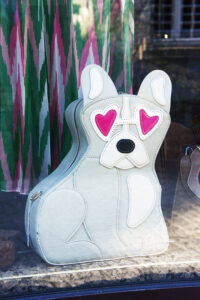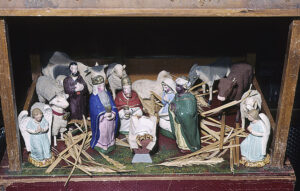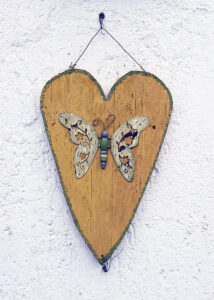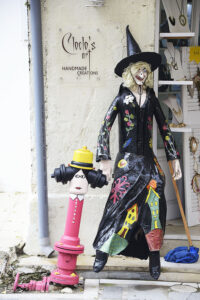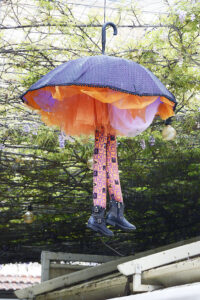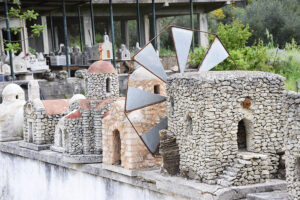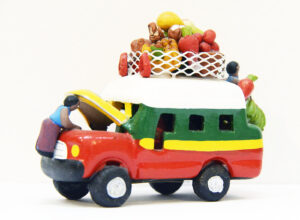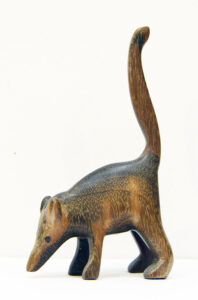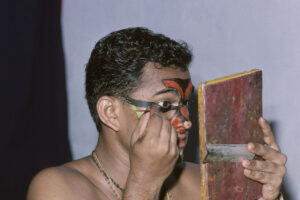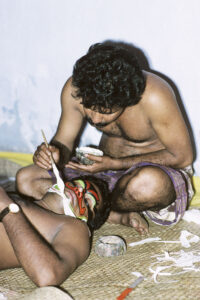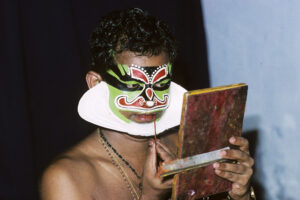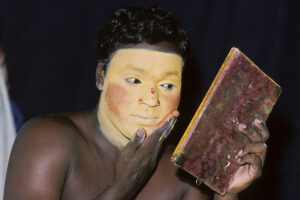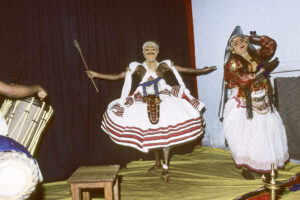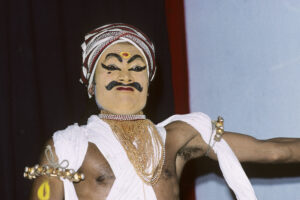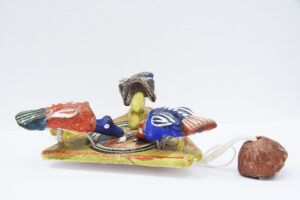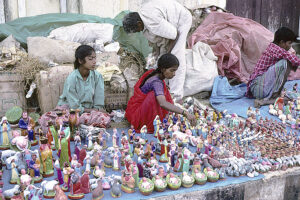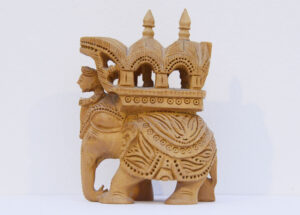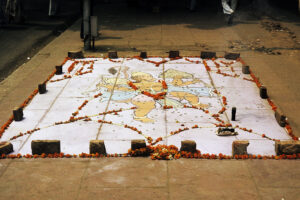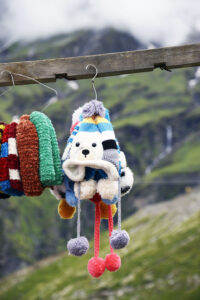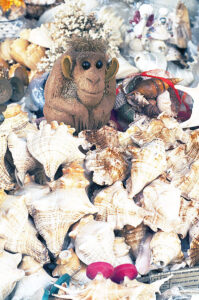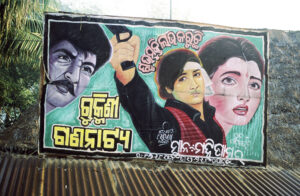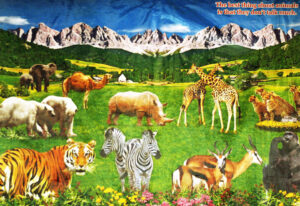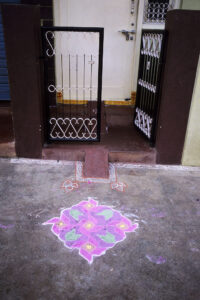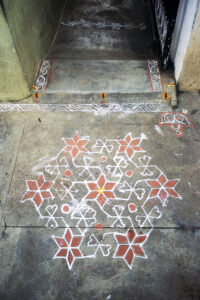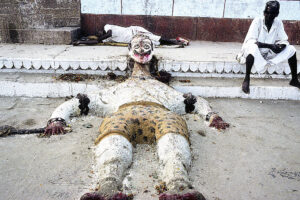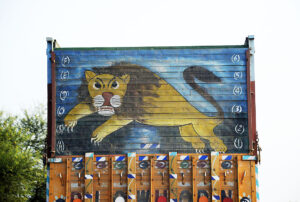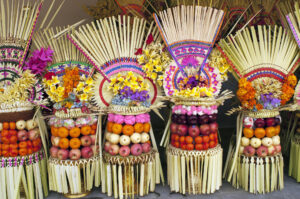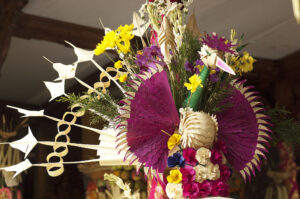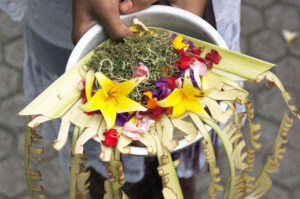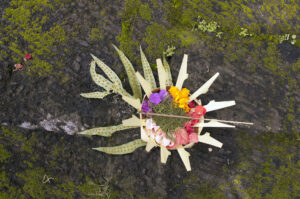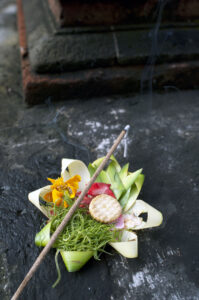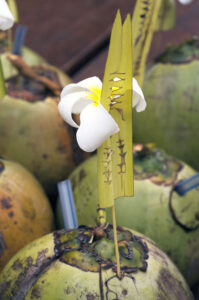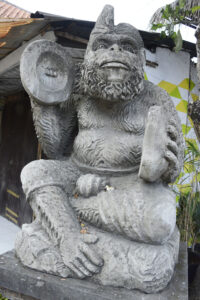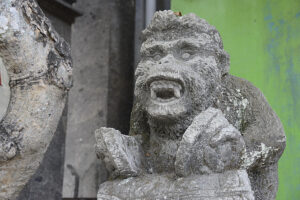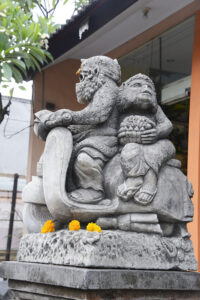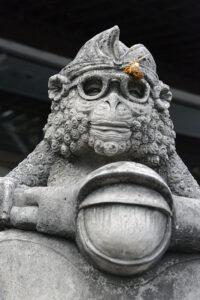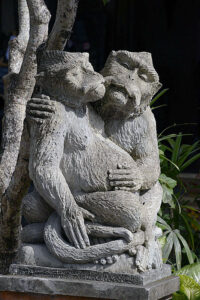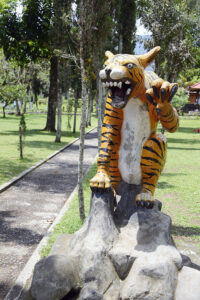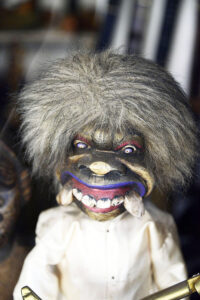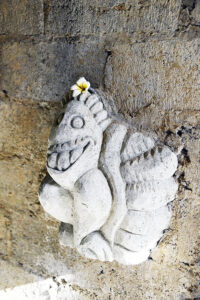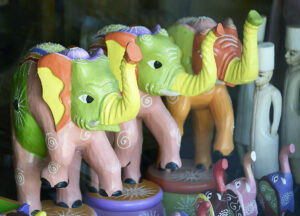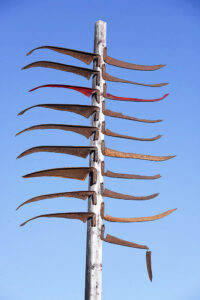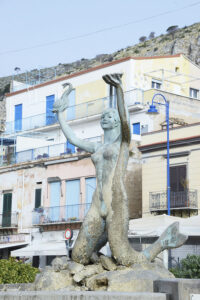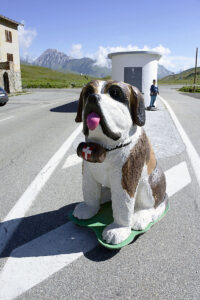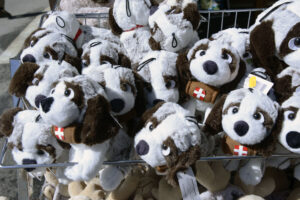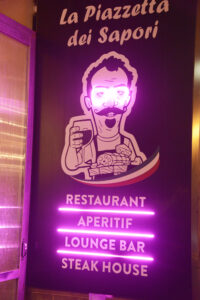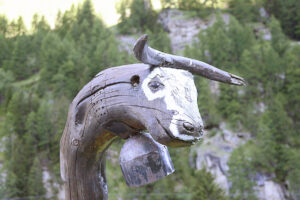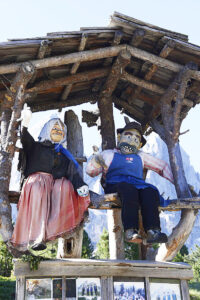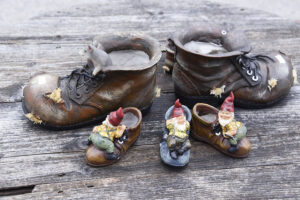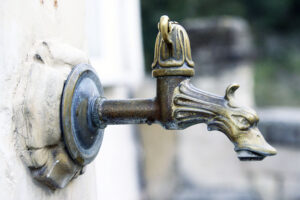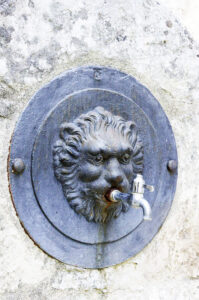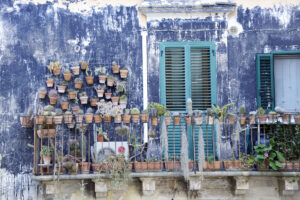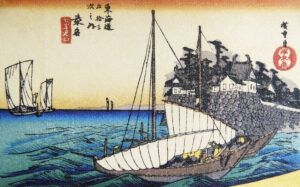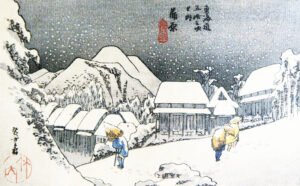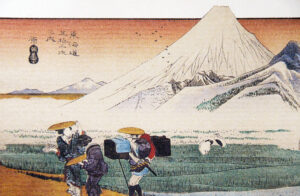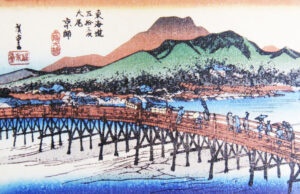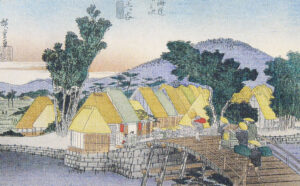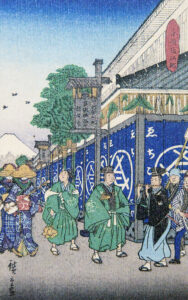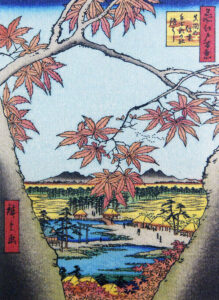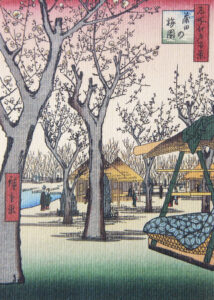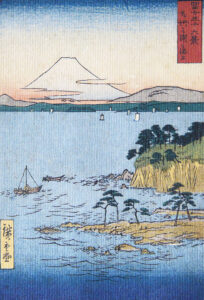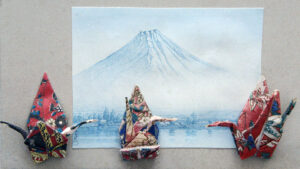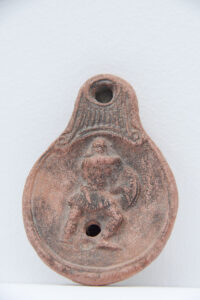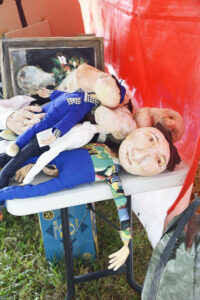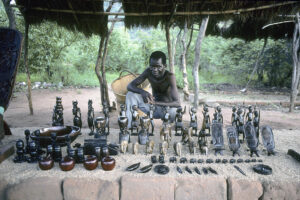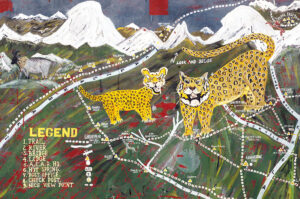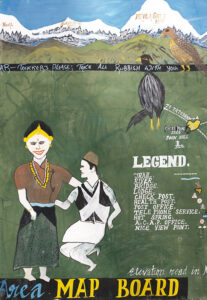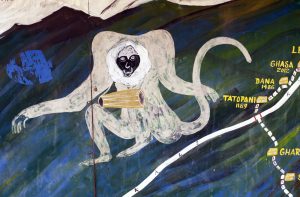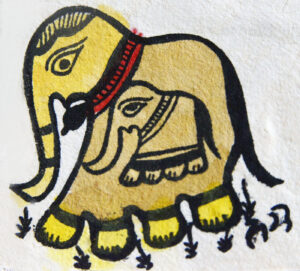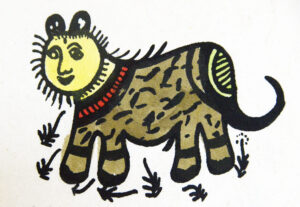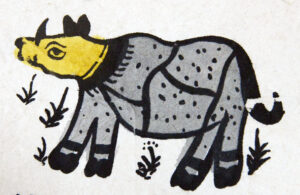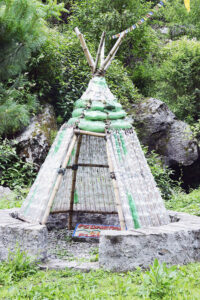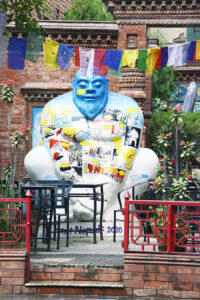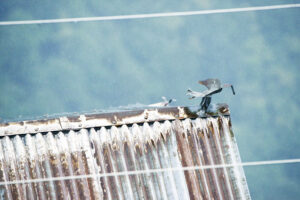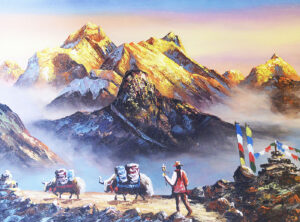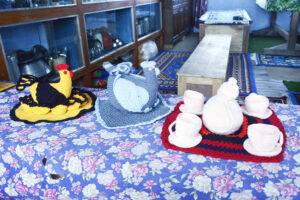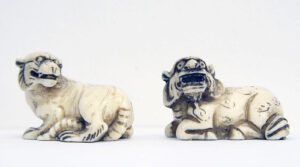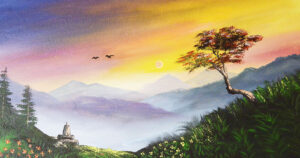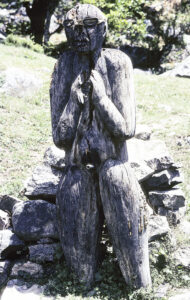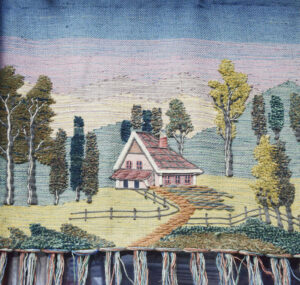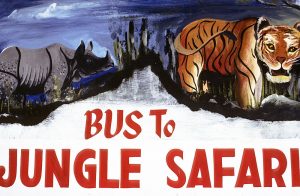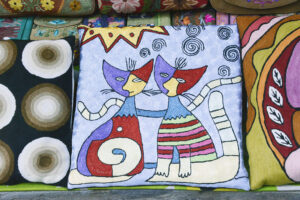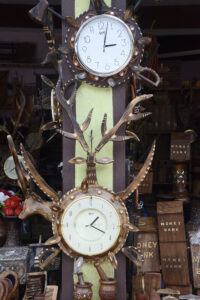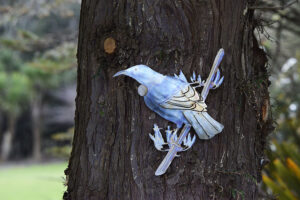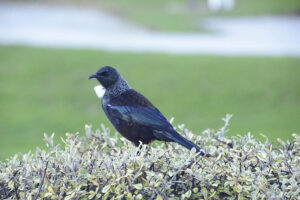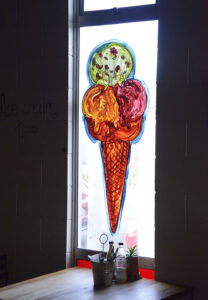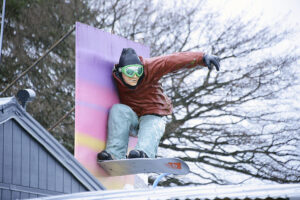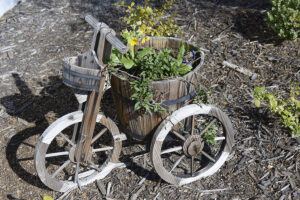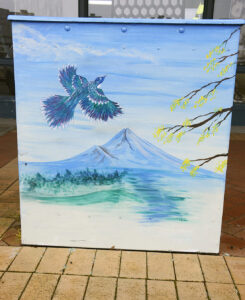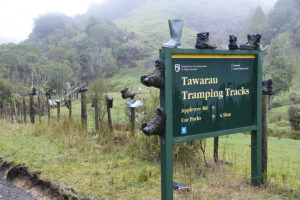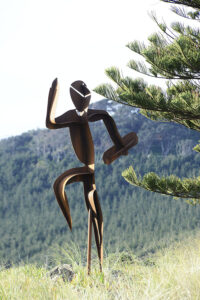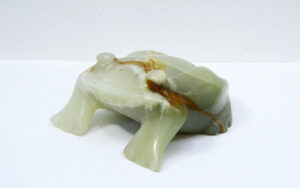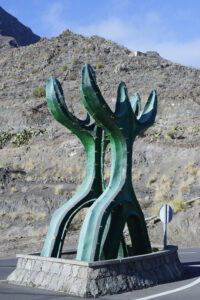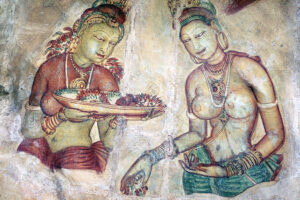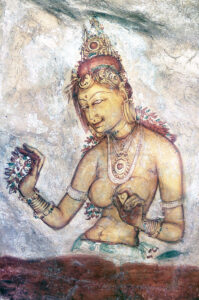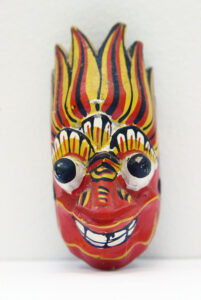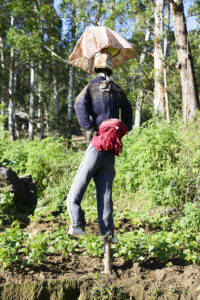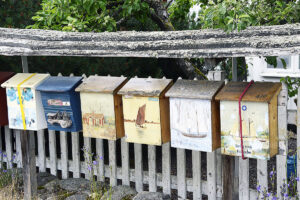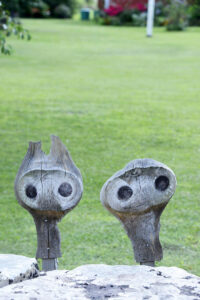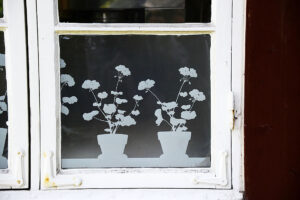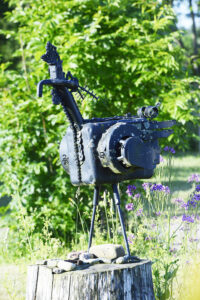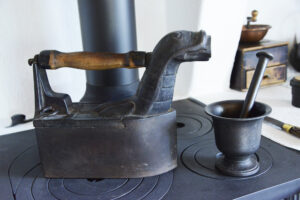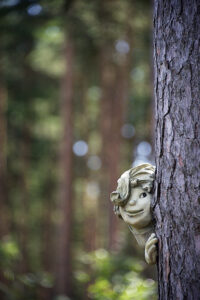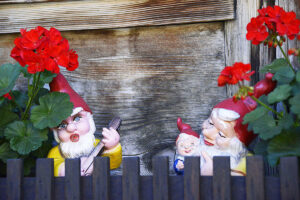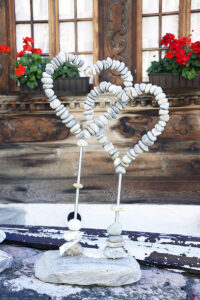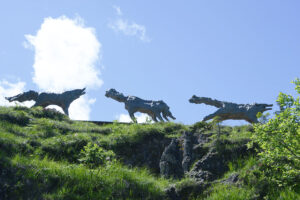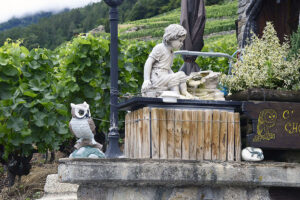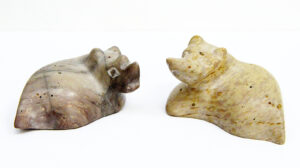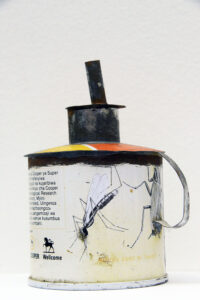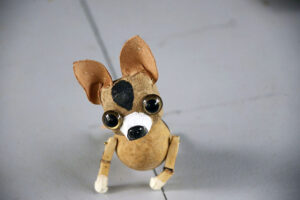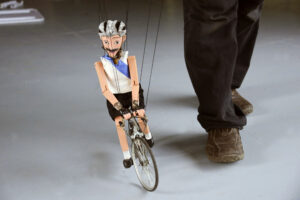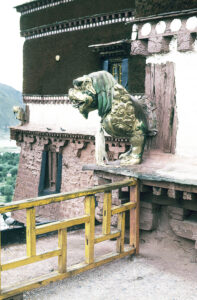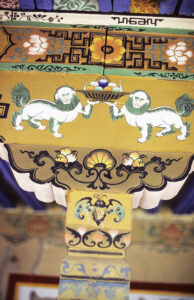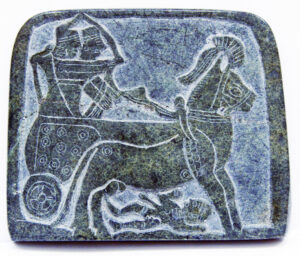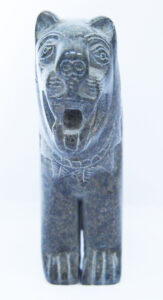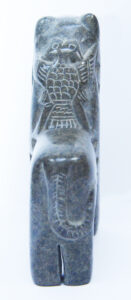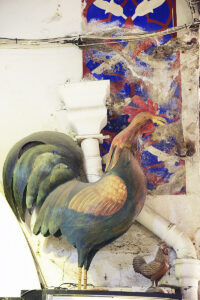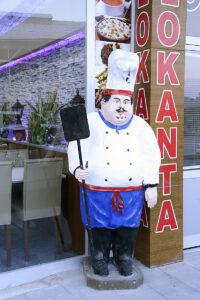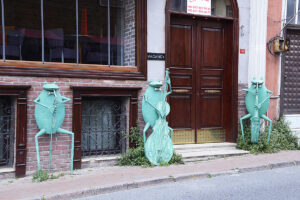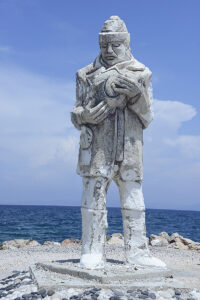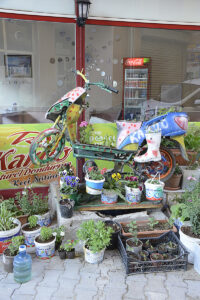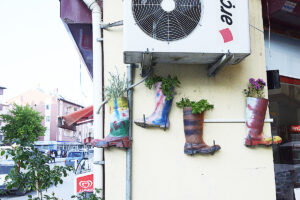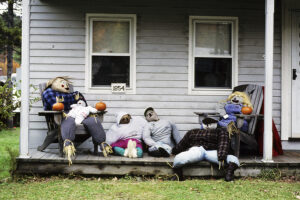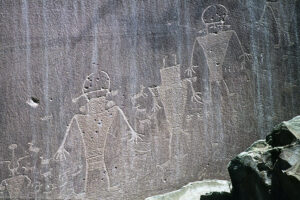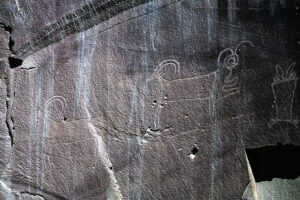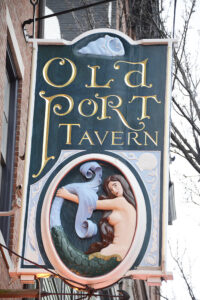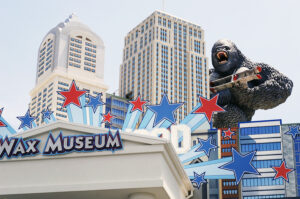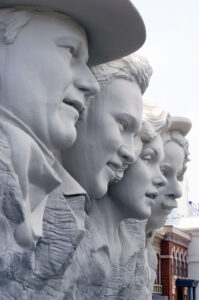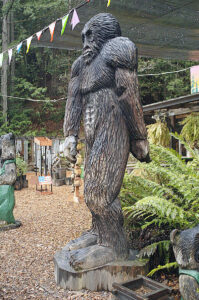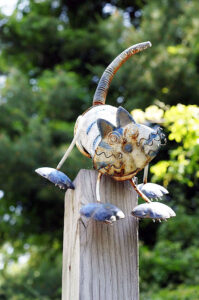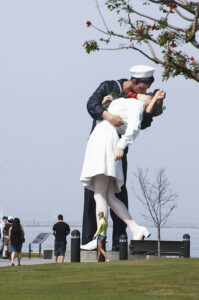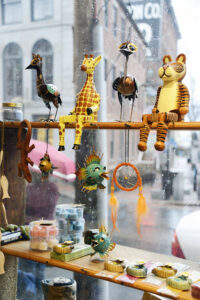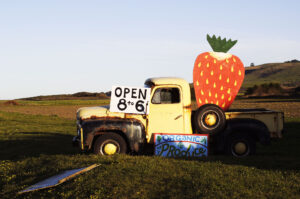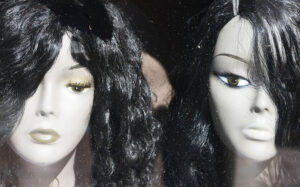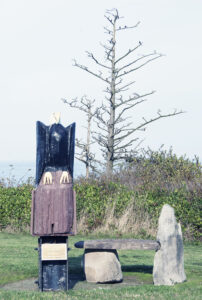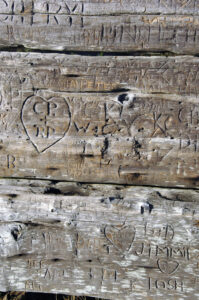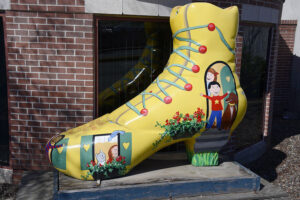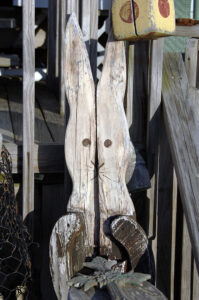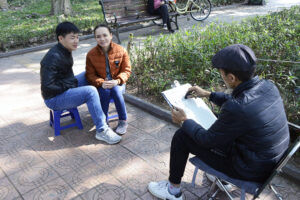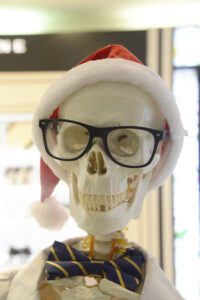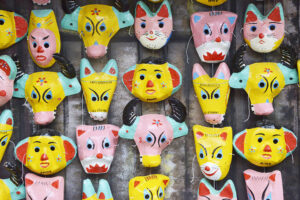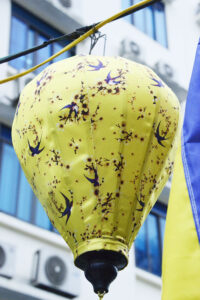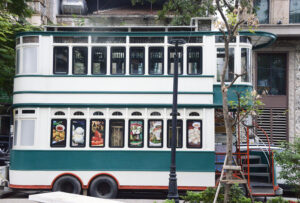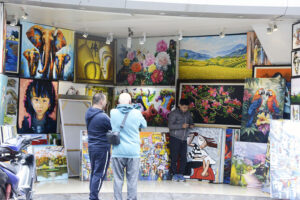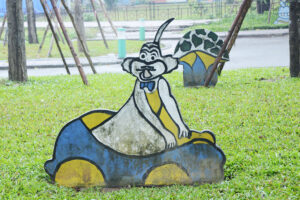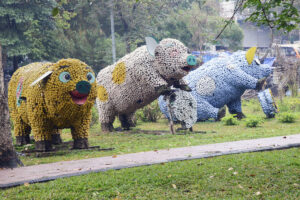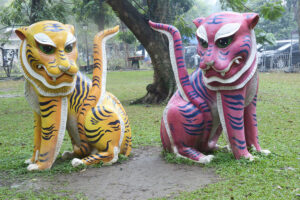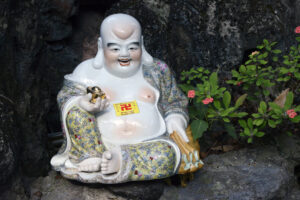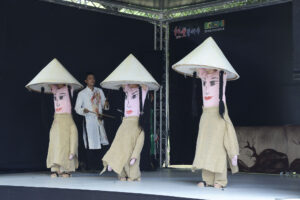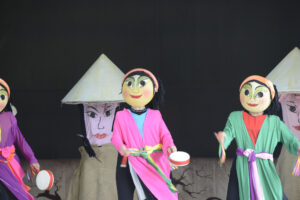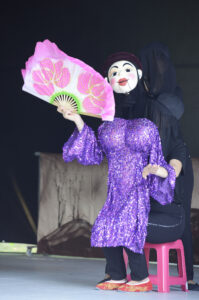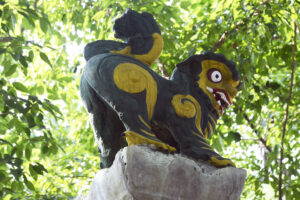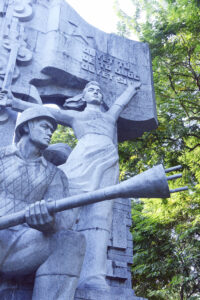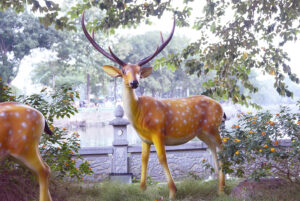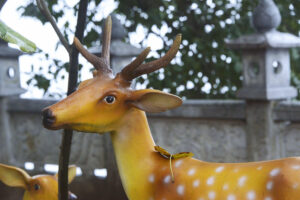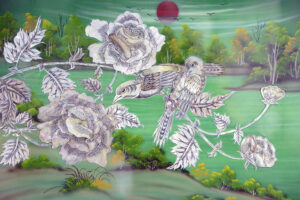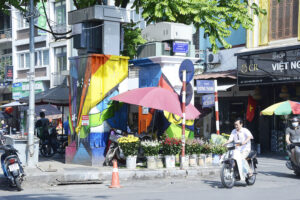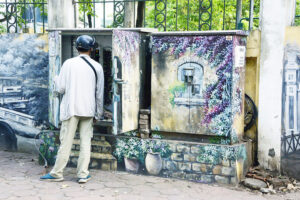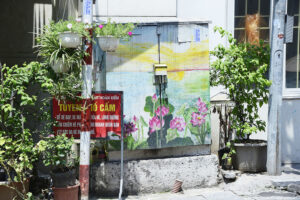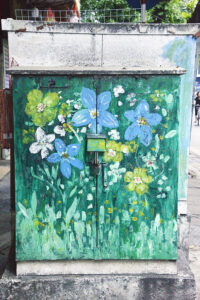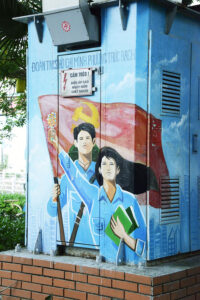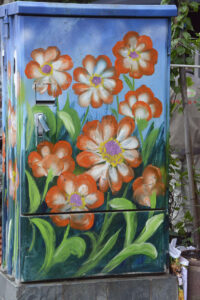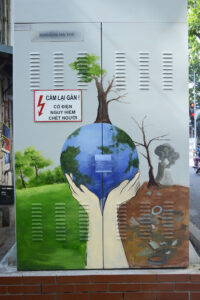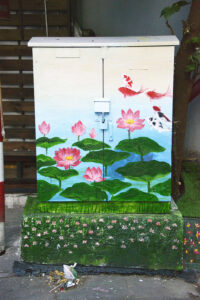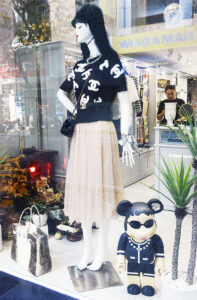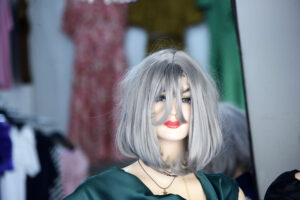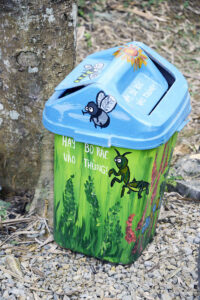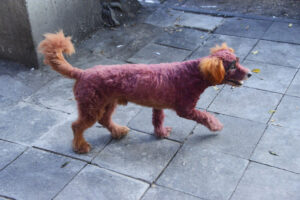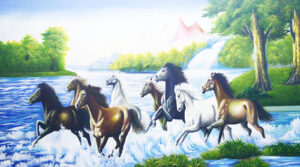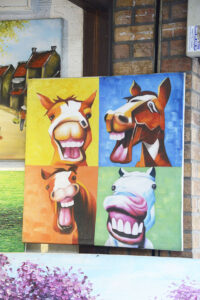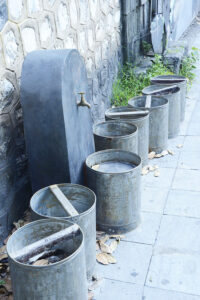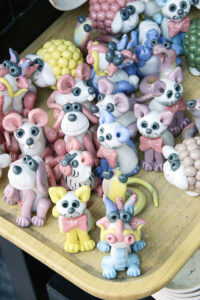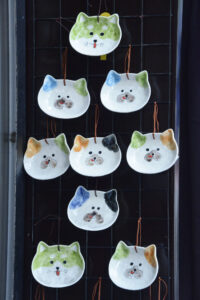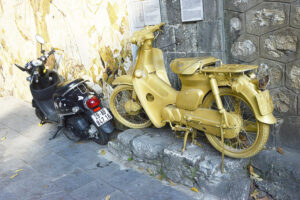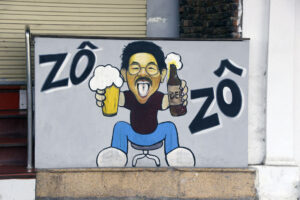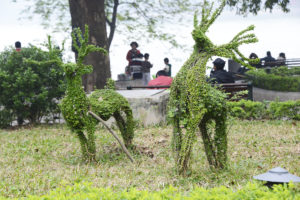Folk art around the world
A lustful guy, constructed of a spruce trunk and branches, Vrata Valley, Triglavski National Park, Slovenia. (Photo copyright © by Kaj Halberg)
A street vendor in Zhongdian, Yunnan Province, China, has produced this figure, depicting a crane, from melted sugar. (Photo copyright © by Kaj Halberg)
This angel, virtuously dressed, blows a trumpet, Nylars Church, Bornholm, Denmark. (Photo copyright © by Kaj Halberg)
Kitschy eye-catcher at a restaurant, Enkhuizen, Holland. (Photo copyright © by Kaj Halberg)
On this page, a collection of pictures show folk art from various countries around the world, arranged alphabetically according to country name.
Pictures, depicting wall paintings, artwork on rocks, and murals inside churches, are shown on a separate page, Culture: Wall and rock art, and pictures of the rich and varied folk art in Taiwan are also shown on a separate page.
Austria
This fine dragon, displayed near Lake Toplitz, Bad Aussee, has been made from scrap metal and chicken wire. (Photo copyright © by Kaj Halberg)
Cameroun
The roof of this house, encountered in a village in the Kapsiki Mountains, is a true piece of artwork, consisting of beautifully woven mats. The bird is a pied crow (Corvus albus), a common bird in sub-Saharan Africa. (Photo copyright © by Kaj Halberg)
China
Pictures from Tibet are dealt with in a separate section.
A street vendor in Zhongdian, Yunnan Province, has produced these figures, depicting a crane and a rooster, from melted sugar – a popular treat among local children. (Photos copyright © by Kaj Halberg)
This tablecloth, which is batik from the Guizhou Province, shows a procession of rats during a wedding. The upper picture is the right part of the cloth, the lower picture the left part. (Photos copyright © by Kaj Halberg)
Kitschy sculpture, depicting a dragon, a pigeon, and flowers – an eye-catcher for CDF Beijing Airport duty-free shops. (Photo copyright © by Kaj Halberg)
Paper cutting, depicting a crane, Guiyang, Guizhou Province. (Photo copyright © by Kaj Halberg)
Kitschy sculptures, depicting great pandas (Ailuropoda melanoleuca), Beijing Airport. The great panda is described on the page Sleep. (Photo copyright © by Kaj Halberg)
Examples of prints on rice paper: Cat and butterflies, and tiger. (Photos copyright © by Kaj Halberg)
Fleeting street art: This man is writing Chinese characters with water on the pavement, Guiyang, Guizhou Province. (Photo copyright © by Kaj Halberg)
These gaudy sculptures are displayed at a fountain in Beijing Airport. The official airport text says: “In 1979, Chinese artist Yuan Yunsheng completed the mural The Water-sprinkling Festival – a Hymn of Life, in Beijing Capital International Airport. Based on folklore, it mainly describes the grand scene of the Water-splashing Festival and reveals people’s beautiful wishes of loving life, pursuing freedom and yearning for happiness. In order better to narrow the boundary between art and society, and release the liveliness and vitality of art, the airport stereoscopically restored the mural content in a ratio of one to one.” – Like that! Hard to swallow?
(Photos copyright © by Kaj Halberg)
This paper cutting, depicting a tribal village and people working in rice fields, was made by Yao (Jiao) tribals in the town of Duyun, Guizhou Province. (Photo copyright © by Kaj Halberg)
Crane, made from paper, Anshun, Guizhou Province. (Photo copyright © by Kaj Halberg)
Costa Rica
Tortuguero is a small village, situated on an island in Tortuguero National Park on the north-western shore of Costa Rica. Many of the inhabitants are very creative. This picture shows decorated cans for various types of garbage. (Photo copyright © by Kaj Halberg)
The Central American white-faced capuchin (Cebus imitator) is native to forests of Honduras, Nicaragua, Costa Rica, and western Panama. It is described in depth on the page Animals – Mammals: Mammals in Costa Rica and Guatemala.
Until recently, this animal was considered conspecific with the Columbian white-headed capuchin (C. capucinus), which is found in coastal areas from eastern Panama southwards to Ecuador.
The great curassow (Crax rubra), of the family Cracidae, is a large, pheasant-like bird distributed from eastern Mexico eastwards through Central America to western Colombia and north-western Ecuador.
This sign outside a tour agency in Tortuguero is advertizing jungle trips, using a rather long-bearded white-faced capuchin, and a great curassow as eye-catchers. (Photo copyright © by Kaj Halberg)
Decorated trolley of a street vendor, Cahuita, Limón. (Photo copyright © by Kaj Halberg)
Porcelain figures for sale at the Old Market, San José: an angel, Virgin Mary, and perhaps the Three Wise Men. (Photo copyright © by Kaj Halberg)
This sculpture in San José depicts a well-fed woman. (Photos copyright © by Kaj Halberg)
Denmark
In Denmark, in the old days, it was believed that benevolent gnomes, called nisser, were living in the attic of farmhouses and elsewhere. However, if they got annoyed they could harm humans. At Christmas time, people would place a bowl of rice porridge in the attic for the nisser. Miraculously, the bowl would be empty the following morning, and people believed that the nisser had found the porridge satisfactory. I’m sure that the rats and mice, which had eaten the porridge, found it satisfactory!
Later, at Christmas time, it became a widespread custom to decorate your home with small cardboard nisser, popularly called kravlenisser (‘crawling nisser’), as they were often placed on picture frames.
Nisser, adorning windows at Christmas time, Funen. (Photo copyright © by Kaj Halberg)
Cardboard nisse from the early 1900s, Funen. (Photo copyright © by Kaj Halberg)
This old horse wagon now functions as a flower bed, Funen. (Photo copyright © by Kaj Halberg)
Dog shit, no thank you! – Home-made sign, Nyborg, Funen. (Photo copyright © by Kaj Halberg)
Carved heart in the trunk of a Swedish whitebeam (Sorbus intermedia), Lyø, Funen. This species is described on the page Plants: Ancient and huge trees. (Photo copyright © by Kaj Halberg)
Children’s art: an ogre made from a coconut shell, grass, and an old nylon stocking, Jutland. (Photo copyright © by Kaj Halberg)
Small models, depicting a baker and his wife, Funen, Denmark. (Photo copyright © by Kaj Halberg)
Ceramic sculpture, made by Emil Krag Madsen, 7 years old. (Photo copyright © by Kaj Halberg)
Various types of bird nesting boxes, Funen. (Photo copyright © by Kaj Halberg)
Drawings by school children on an information board at Lake Ejstrup, Jutland. (Photos copyright © by Kaj Halberg)
Very simple artwork, Vrads, Jutland. (Photos copyright © by Kaj Halberg)
Cat, carved in metal, Funen. (Photo copyright © by Kaj Halberg)
A small part of ‘Hærvejstæppet’, inside the Søndermark Church, Viborg. This tapestry, measuring 10 by 1 m, relates the varied history of the ‘Hærvej’, the ancient army and trading road leading south through Jutland. The tapestry was made over 5 years by about 20 women. The motives were originally made as watercolours by artist Inga Linde Jensen, and then sown onto linen. (Photos copyright © by Kaj Halberg)
This friendly ogre has been placed in a knot on a tree trunk on the island of Bornholm. (Photo copyright © by Kaj Halberg)
Cast-iron entrance gate, depicting a blacksmith, Vemmetofte, Zealand. (Photo copyright © by Kaj Halberg)
Alternative musical instruments, eastern Jutland. (Photo copyright © by Kaj Halberg)
School windows, decorated by children, Lyø, Funen. (Photos copyright © by Kaj Halberg)
Bulldog, made from cement, Hjortshøj, north of Aarhus. (Photo copyright © by Kaj Halberg)
Originally, the ring-necked pheasant (Phasianus colchicus) was native to Asia, from the Caucasus eastwards to China and Taiwan. However, it was introduced in Europe as a hunting object, maybe as early as around year 1000, and in North America in 1773. Today, it is firmly established as a feral bird in major parts of both continents.
Iron sculptures, depicting ring-necked pheasants, Funen, Denmark. (Photo copyright © by Kaj Halberg)
Mask and rooster, made by village people in eastern Jutland. (Photos copyright © by Kaj Halberg)
These figures, depicting a man and two Dalmatian dogs, adorn a garden wall in the town of Rønne, Bornholm. (Photo copyright © by Kaj Halberg)
“Once upon a time…” – Cow, dressed up for a party, reading out from a book, Jutland. (Photo copyright © by Kaj Halberg)
‘Bird cage’, constructed of prickly rose stems, Zealand. (Photo copyright © by Kaj Halberg)
Humorous graffiti on a trail marker, Hammerknuden, Bornholm. (Photo copyright © by Kaj Halberg)
This carving depicts an Underjordisk (‘Underground Dweller’), a local type of gnome, which is unique to the island of Bornholm. (Photo copyright © by Kaj Halberg)
Penny farthing, Vejle, Jutland. (Photo copyright © by Kaj Halberg)
France
Decorated drain pipe, Dinan, Brittany. The plant is Mexican fleabane (Erigeron karvinskianus), described on the page Plants: Urban plant life. (Photo copyright © by Kaj Halberg)
Folk art in the village Kerampeulven, Brittany, including a windmill, made of small wooden pieces. (Photo copyright © by Kaj Halberg)
This bar in the city Huelgoat, Brittany, called ‘The Blue Owl’, uses a blue owl as an eye-catcher. (Photo copyright © by Kaj Halberg)
Decorated rear part of a Citroen 2CV, depicting a landscape with an Alpine marmot (Marmota marmota), Pointe du Toulinguet, Brittany. This animal is described on the page Animals – Mammals: Squirrels. (Photo copyright © by Kaj Halberg)
Puppet and house number, made from small, flat stones, Locronan, Brittany. (Photo copyright © by Kaj Halberg)
This sculpture in the city Quimper, Brittany, depicts a man clad in a dress of former times. (Photo copyright © by Kaj Halberg)
Eye-catcher outside a baker’s shop, Quimper. (Photo copyright © by Kaj Halberg)
Would you buy these souvenirs, exhibited for sale in a shop in Quimper? (Photos copyright © by Kaj Halberg)
Folk art in Pont L’Abbé, Brittany: A little egret (Egretta garzetta), climbing up a palm tree. This species is described several places on this website, including Animals – Birds: Birds in Africa. (Photo copyright © by Kaj Halberg)
A church wall in the city of Malestroit, Brittany, has been adorned with several more or less puzzling sculptures. Green algae were growing on most of the figures.
This sculpture depicts a person with one of his hands inside the mouth of a lion. (Photo copyright © by Kaj Halberg)
This figure is standing on his arms, with his feet resting on his neck. (Photo copyright © by Kaj Halberg)
Two monsters, tearing a person apart. (Photo copyright © by Kaj Halberg)
Does this billy goat depict the Devil himself? (Photo copyright © by Kaj Halberg)
An ox. (Photo copyright © by Kaj Halberg)
‘Waitress’ outside a restaurant, Malestroit, Brittany. (Photo copyright © by Kaj Halberg)
Kitschy dog, made from felt, Rochefort en Terre, Brittany. (Photo copyright © by Kaj Halberg)
Germany
This picture shows Catholic handicrafts from c. 1890, possibly originating in Germany, depicting the Three Wise Men, honouring the newborn Jesus in the stables. According to legend, one of the Wise Men was black. The rise of Christianity is described on the page Religion: Christianity. (Photo copyright © by Kaj Halberg)
Heart with a butterfly, constructed of wood, Thierstein, Bavaria. (Photo copyright © by Kaj Halberg)
Greece
This colourful witch has been displayed as an eye-catcher outside a souvenir shop in the city of Rethymno, Crete. It was placed beside a fire hydrant, which has been painted to depict a young girl with a fancy hairstyle, wearing a yellow hat. (Photo copyright © by Kaj Halberg)
This ’well’ in the town of Chania, Crete, is made from various items, including decorated car tyres and a toy bucket. (Photo copyright © by Kaj Halberg)
’Girl’ beneath an umbrella, Rethymno, Crete. (Photo copyright © by Kaj Halberg)
Tiny buildings, including a windmill, constructed of pebbles, near Kolimvari, Crete. (Photo copyright © by Kaj Halberg)
Guatemala
Car, carved in wood. (Photos copyright © by Kaj Halberg)
Coati, carved in wood. These small carnivores are described on the page Animals – Mammals: Long-nosed coatis – charming bandits. (Photo copyright © by Kaj Halberg)
India
Kathakali is a dancing form, about 500 years old, from Kerala, which may still take place in certain villages. Today, however, it is mostly performed for tourists. This dance relates dramas, in which the theme is most often taken from the Hindu epics Mahabharata and Ramayana (more about these epics on the page Religion: Hinduism). All dancers are males.
This dance is a complicated pantomime, in which not only the dancing movements, but also facial mimic and eye movements are important elements. The dancers are clad in fantastic costumes, and the facial painting, which often takes hours to make, is in vivid colours. The dance is accompanied by drums, and the plot is conveyed through a singer.
The pictures below, from Kochi, Kerala, show a Kathakali dance, relating Keechaka Vadham (‘Keechaka is killed’), an episode from Mahabharata. The Pandava brothers (more about these on the page Religion: Hinduism) have sought asylum at King Virada’s court. The king’s brother-in-law Keechaka falls in love with Malini, one of the Pandava wives, and courts her. She complains to Bhima, who kills Keechaka.
Make-up is done on the dancer, depicting Keechaka. (Photos copyright © by Kaj Halberg)
Make-up is done on the dancer, depicting Malini. (Photos copyright © by Kaj Halberg)
This scene shows Keechaka, courting Malini. (Photo copyright © by Kaj Halberg)
Malini complains to Bhima. (Photo copyright © by Kaj Halberg)
An angry Bhima. (Photo copyright © by Kaj Halberg)
Foraging chickens, bought in Varanasi. The head of the chickens can move up and down by the help of cotton yarn, which leads through a hole, where it is tied to a small stone ball. When you hold the handle and whirl the ball around, it pulls the head of the chickens alternately, causing them to ‘feed’. (Photo copyright © by Kaj Halberg)
Street vendors, selling brightly coloured ceramic figures to Catholic churchgoers, Puducherri (Pondicherry), southern India. (Photo copyright © by Kaj Halberg)
Procession elephant, carved in wood, South India. (Photo copyright © by Kaj Halberg)
Street painting, depicting the Hindu monkey god Hanuman, Delhi. The artwork has been decorated with marigolds. (Photo copyright © by Kaj Halberg)
In spring and autumn, the Rohtang La Pass, Himachal Pradesh, is a very popular destination for Indian tourists, and below the pass, numerous dhabas (small road-side restaurants) have sprung up helter-skelter. Also, woollen hats and other warm clothes are sold to the lowlanders who are very sensitive to cold.
Woollen hats, displayed for sale in Marki below the pass. (Photo copyright © by Kaj Halberg)
This monkey, carved out of a coconut husk, has been placed to attract buyers’ attention to conches, displayed for sale in a bazaar, Haridwar, Uttarakhand. (Photo copyright © by Kaj Halberg)
Poster, advertizing a movie in the Oriya language, Rajanagar, Odisha. (Photo copyright © by Kaj Halberg)
Indian poster, depicting some kind of animal ‘Garden of Eden’, with words of wisdom (?). (Photo copyright © by Kaj Halberg)
In India, during certain Hindu festivals, it is a common practice to decorate the entrance to your home every morning with crayons. These pictures show mandalas (stylized figures, depicting the Universe), which were made during Sankrati (Hindu New Year) in Mysore, Karnataka. (Photos copyright © by Kaj Halberg)
Krishna is an avatar of the supreme Hindu god Vishnu. Various Hindu gods, and the concept of avatar, are described on the page Religion: Hinduism.
This wood carving from Rajasthan depicts Krishna, playing a flute. (Photo copyright © by Kaj Halberg)
This image, depicting Bhimsen, the Hindu god of trade, has been created in a street in Varanasi, Uttar Pradesh. (Photo copyright © by Kaj Halberg)
Lacquered wooden box, Kashmir. (Photo copyright © by Kaj Halberg)
Painting, depicting a lion, on the backboard of a truck, Haryana. (Photo copyright © by Kaj Halberg)
Indonesia
On the island of Bali, Hinduism is the predomonant religion. Offerings to gods or temples are often small wonders of artwork.
Offerings in a Hindu temple, consisting of carved palm leaves, flowers, fruit, coconuts, fern leaves, and incense sticks, Ubud, Bali. (Photos copyright © by Kaj Halberg)
Kitschy paintings for sale, Ubud, Bali. (Photo copyright © by Kaj Halberg)
The area around the Wenara Wana Temple (popularly called ‘Monkey Forest’), in Ubud, Bali, is home to several troops of long-tailed macaques (Macaca fascicularis). This species and many other monkeys are described on the page Animals – Mammals: Monkeys and apes.
In Ubud, a local artist has created a number of rather anthropomorphic sculptures, depicting these monkeys.
These two macaques are playing cymbals. (Photos copyright © by Kaj Halberg)
This couple, driving on a motorbike, have been adorned with marigold flowers. (Photos copyright © by Kaj Halberg)
A pregnant female. (Photo copyright © by Kaj Halberg)
Various kitschy sculptures are displayed outside Pura Ulun Danu Bratan, a Hindu temple near Lake Bratan, Bali.
A friendly frog. (Photo copyright © by Kaj Halberg)
A fearsome tiger. (Photo copyright © by Kaj Halberg)
Monster puppet, Ubud, Bali. (Photo copyright © by Kaj Halberg)
This sculpture in a wall in Ubud, which depicts a benevolent monster, has been adorned with a frangipani flower (Plumeria rubra). (Photo copyright © by Kaj Halberg)
Kitschy sculpture, depicting a Hindu mythological hero and his consort, Kintamani, Bali. Note the broken arms. (Photo copyright © by Kaj Halberg)
Kitschy souvenirs for sale, Ubud, Bali. (Photos copyright © by Kaj Halberg)
Italy
Worn-out scythes, used as decoration, Passo delle Erbe (Börz Würzjoch), Dolomites. (Photo copyright © by Kaj Halberg)
Kitschy mermaid, Castellamare del Golfo, Sicily. Note that she has legs! (Photo copyright © by Kaj Halberg)
A kitschy Saint Bernard dog, made from gypsum or cement, displayed at the Lesser St. Bernard Pass, on the border between Italy and France. The St. Bernard dog is described on the page Animals: Animals as servants of Man. In the background, another sculpture depicts a French police officer, complete with the red cap, the kepi. (Photo copyright © by Kaj Halberg)
Likewise at the Lesser St. Bernard Pass, lots of synthetic St. Bernard dogs, and a marmot, made from gypsum or cement, were displayed for sale. (Photos copyright © by Kaj Halberg)
Gaudy sign outside a restaurant, Cefalú, Sicily. (Photo copyright © by Kaj Halberg)
Using a little paint and a cow bell, the end of this curved branch has been made into a friendly cow, Gran Paradiso National Park. (Photo copyright © by Kaj Halberg)
Life-size dummies, depicting an elderly farmer couple, Passo delle Erbe (Börz Würzjoch), Dolomites. (Photo copyright © by Kaj Halberg)
Kitschy ceramics, depicting old shoes with mice and gnomes, for sale at Passo Falzarego, Dolomites. (Photo copyright © by Kaj Halberg)
Two examples of water taps, Ragusa, Sicily. (Photos copyright © by Kaj Halberg)
An abundance of flower pots, beautifully arranged, Ragusa, Sicily. (Photo copyright © by Kaj Halberg)
Japan
These pictures show Japanese wood block printings. (Illustrations: Public domain)
Following the nuclear destruction of the Japanese cities Hiroshima and Nagasaki, thousands of paper cranes were folded by Japanese school children, symbolizing peace. (Photos copyright © by Kaj Halberg)
Jordan
Clay lamp with two holes, one for the wig, the other to pour in oil. The figure on the lamp depicts a Mesopotamian warrior. (Photo copyright © by Kaj Halberg)
Korea
Korean marionette puppets. (Foto copyright © by Kaj Halberg)
Malawi
This road vendor is selling locally produced wood carvings as souvenirs, Chembe, Lake Malawi. (Photo copyright © by Kaj Halberg)
Nepal
“Look and decide!”
Along many trails in the Himalaya, interesting information boards, painted by local artists, are displayed, showing hiking trails, mountains, rivers, villages, and a selection of the local wildlife. The boards below were all encountered in the Modi Khola Valley, Annapurna.
This board depicts a Himalayan tahr (Hemitragus jemlahicus), a leopard (Panthera pardus), and a creature, which is probably supposed to be a snow leopard (Panthera uncia), but rather more resembles a hybrid between a leopard and a tiger (Panthera tigris). (Photo copyright © by Kaj Halberg)
This board shows mountains, a dancing couple, and a pair of kalij pheasants (Lophura leucomelanos). (Photo copyright © by Kaj Halberg)
In this painting, a pale-armed langur (Semnopithecus schistaceus) is playing a tabla. – Langurs and many other monkeys are described on the page Animals – Mammals: Monkeys and apes. (Photo copyright © by Kaj Halberg)
The drawings below, depicting an Asian elephant (Elephas maximus), a tiger (Panthera tigris), and an Indian rhino (Rhinoceros unicornis), were created for a calendar by women in the terai (the lowland of Nepal), who were selling these calendars and other items to improve their living standard. All three species are described on the page Animals – Mammals: Mammals in the Indian Subcontinent.
(Photos copyright © by Kaj Halberg)
Tent, made from plastic bottles, Bamboo, Langtang Valley. (Photo copyright © by Kaj Halberg)
Gaudy sculpture, depicting a yeti, Kathmandu. (Photo copyright © by Kaj Halberg)
Metal work on a house roff, depicting a bird, Sherpagaon, Langtang Valley. (Photo copyright © by Kaj Halberg)
Scarecrow, made from old clothes, Shyabru, Langtang National Park. (Photo copyright © by Kaj Halberg)
Kitschy painting for sale, Kathmandu. (Photo copyright © by Kaj Halberg)
Knitwear, depicting chickens and a tea set, Kutumsang, Helambu. (Photo copyright © by Kaj Halberg)
The snow lion is a mythical creature of Central Asia, which, according to local belief, ranges over mountains and glaciers. It symbolizes strength, fearlessness, and joy. These figures, carved in cow- or buffalo horn, were bought near the huge Bodhnath Temple in Kathmandu. I was told by the salesman that they must never be parted, and I have faithfully complied with this. (Photo copyright © by Kaj Halberg)
Kitschy painting, Shyabrubesi. (Photo copyright © by Kaj Halberg)
A lustful guy, carved in wood. His penis is a metal pipe, acting as a faucet. – Ghora Tabela, Langtang National Park. (Photo copyright © by Kaj Halberg)
Kitschy cross stich, Kathmandu. (Photo copyright © by Kaj Halberg)
Sign in Kathmandu, advertising jungle safaris to Chitwan National Park, which apparently is home to enormous tigers! (Photo copyright © by Kaj Halberg)
Pottery, depicting elephants, Kathmandu. (Photo copyright © by Kaj Halberg)
This urinating man, clad only in a topi (Nepalese style hat), has been painted on a house beam in the village of Landrung, Modi Khola Valley, Annapurna. (Photo copyright © by Kaj Halberg)
Kitschy pillow case, Kathmandu. (Photo copyright © by Kaj Halberg)
Gaudy clocks for sale, one shaped as a deer, with antlers and all, Manakamana Kali Temple, central Nepal. (Photo copyright © by Kaj Halberg)
New Zealand
The tui (Prosthemadera novaeseelandiae) is one of only two members of the honeyeater family (Meliphagidae) in New Zealand. It is common throughout the country. An older name of this bird is parsons bird, so named due to the two white tufts of feathers on its throat, which, to the early European settlers, resembled a vicar’s collar.
This iron sculpture, depicting a tui, has been nailed onto a tree in the town of Ohakune. The sculpture is very accurate, as you can see by comparing it with the bird in the bottom picture. (Photos copyright © by Kaj Halberg)
Cone with ice cream, painted on the window of a restaurant, Patea. (Photo copyright © by Kaj Halberg)
This kitschy sculpture, depicting a snow surfer, is placed above a shop in Ohakune, where winter sports equipment is sold or rented out. (Photo copyright © by Kaj Halberg)
This sculpture in New Plymouth depicts a friendly kelp gull (Larus dominicanus), a common bird along the coasts of the entire country. (Photo copyright © by Kaj Halberg)
Wooden flower pot, formed like a bicycle, Ohakune. (Photo copyright © by Kaj Halberg)
Kitschy art on an electric meter box, Stratford. (Photo copyright © by Kaj Halberg)
Might this odd sculpture, exhibited at Ohakune Railway Station, represent a cyclist? (Photo copyright © by Kaj Halberg)
On several locations in New Zealand, large collections of worn-out trekking boots, and other footwear, have been placed on fences and other places, in this case near Tawarau, North Island. (Photo copyright © by Kaj Halberg)
Iron sculpture near Muriwai Beach, depicting a jogger. (Photo copyright © by Kaj Halberg)
Pakistan
Frog, carved in stone. (Photo copyright © by Kaj Halberg)
Philippines
Ifugao warrior, carved in wood by Ifugao carver Joseph Blas, Banawe, Luzon. (Photo copyright © by Kaj Halberg)
Spain
This piece of art depicts a pole vaulter, San Nicolas, Gran Canaria. In former days, such poles were used in the Canary Islands, when people were crossing streams or narrow gorges. (Photo copyright © by Kaj Halberg)
This sculpture is an eye-catcher for Cactualdea Park, San Nicolas, Gran Canaria, which holds cactus species and other succulent plants. (Photo copyright © by Kaj Halberg)
These sculptures in Gran Canaria depict a hunter and his dog. Note that the barrel of the gun is broken. (Photo copyright © by Kaj Halberg)
Sri Lanka
The verses below, often referred to as ‘graffiti’, are just three among many, which were written, probably in the 8th and 9th Centuries A.D., on a rock named Sigiriya (‘Lion Rock’), eastern Sri Lanka, in praise of the voluptuous Sinhalese noble ladies, depicted on frescos in a niche on the rock wall.
Construction of a fortress atop Sigiriya has often been ascribed to the Sinhalese King Kasyapa, or Kassapa (ruled 473-495 A.D.) – a terrible man, who killed his own father and tried to kill his brother Moggallana, who was the rightful heir to the throne. Moggallana escaped to India, but later returned to Sri Lanka with an army. A huge battle ensued, during which Kasyapa was killed.
Archaeological excavations have revealed that parts of the fortress were built long before Kasyapa’s reign. (Source: Roloff Beny & John Lindsay Opie 1970. Island Ceylon. Thames & Hudson, London)
I am Poyal, the palace guardsman.
This is my song.
Forgive me, oh long-eyed maid of the mountain side.
Coming hither, my mind was filled by the fair ones.
Seeing them, death no longer dismays me.
(Photo copyright © by Kaj Halberg)
Coming hither,
Piyal saw the long-eyed ladies on the mountain side,
separated from their lover,
grieving for the sufferings of the King,
with eyes like blue lilies in full bloom.
The song sung to the painting.
It seems that someone might have made this verse as a comment to Poyal’s poem above, but misspelt his name.
(Photo copyright © by Kaj Halberg)
Hail! A gold-coloured one on the mountain side,
whose resplendent rosy hand bore a blue water-lily,
bewitched my heart and tore it from another.
(Photo copyright © by Kaj Halberg)
Small wooden mask, depicting a devil-like creature. (Photo copyright © by Kaj Halberg)
This drawing, depicting a butterfly, sucking from a hibiscus flower, was made by a Sri Lankan village boy. (Photo copyright © by Kaj Halberg)
This scarecrow, complete with shoes, scarf, and umbrella, was observed in the central highlands of Sri Lanka. (Photo copyright © by Kaj Halberg)
Sweden
Decorated letter boxes, Pataholm, south of Oscarshamn, Småland. The plants beneath the boxes are harebells (Campanula rotundifolia). (Photo copyright © by Kaj Halberg)
These branches with knots have been shaped to form E.T. and a cat, Öland. (Photo copyright © by Kaj Halberg)
Silhouette cutting in a window, Kivik, Skåne. (Photo copyright © by Kaj Halberg)
‘Rooster’, made from scrap iron, Öland. (Photo copyright © by Kaj Halberg)
Husqvarna iron from the 1800s, with a section for charcoal. The vent is formed as a dragon’s head. To the right an old cast iron mortar and pestle. (Photo copyright © by Kaj Halberg)
Wood fairy, looking out from behind a tree, Öland. (Photo copyright © by Kaj Halberg)
Switzerland
Gnomes are much utilized as decoration in the Alps. In this picture from Boltigen im Simmental, they have been placed among scented geraniums (Pelargonium hortonum), the most popular house plant in the Alps. (Photo copyright © by Kaj Halberg)
Hearts, made from small stones with a hole in the centre, likewise from Boltigen im Simmental. In the background scented geraniums. (Photo copyright © by Kaj Halberg)
Metal sculptures, depicting a pack of wolves, Col de la Croix, Valais. (Photo copyright © by Kaj Halberg)
Owl and boy – kitschy art in the village of Plan Cerisier, Rhone Valley. (Photo copyright © by Kaj Halberg)
Taiwan
Pictures, depicting the rich and varied folk art of Taiwan, are presented on separate pages, see Culture: Folk art of Taiwan, and Culture: Wall paintings.
Tanzania
Rhino and hippo, carved in soapstone. (Photo copyright © by Kaj Halberg)
Lamp, made from a former spray can, containing insect repellent. (Photo copyright © by Kaj Halberg)
Thailand
The Chihuahua is the smallest dog breed in the world, standing only up to 30 cm high and weighing between 1.5 and 3 kilograms. This breed first evolved in Mexico, apparently descended from a breed called Techichi, which was a popular dog among the Toltec people.
This wooden Chihuahua is used in a puppet show, performed by Phuket Marionette, a Thai puppet marionette group. (Photo copyright © by Kaj Halberg)
A ‘cyclist’ during the same performance. (Photo copyright © by Kaj Halberg)
Tibet
The snow lion is a mythical creature of Central Asia, which, according to local belief, ranges over mountains and glaciers. It symbolizes strength, fearlessness, and joy. Another picture is seen above, under Nepal.
Sculpture, Potala Palace, Lhasa. (Photo copyright © by Kaj Halberg)
Decorated pillar in the parliament hall inside the old fort, Gyantse. Note that the butterfly has been adorned with eyes. (Photo copyright © by Kaj Halberg)
Turkey
About 1600 B.C., an Indo-European people, whom we call Hittites, established an empire, centered around the city of Hattuşa, whose ruins are situated near the present town of Boğazkale, central Anatolia. This empire reached its peak around 1350-1300 B.C., during the rule of King Suppiluliuma I, when the major part of Anatolia, as well as what is today northern Lebanon, Syria, and Iraq, were conquered.
The term Hittite is modern, taken from the Bible, and has nothing to do with this people. They called themselves the ‘People of the Land of Hatti’.
The carvings illustrated below were produced in Hattuşa in 2006.
Procession of nobility with lions, and an image of a double-headed eagle, which has been interpreted as a royal emblem. (Photo copyright © by Kaj Halberg)
Hittite war chariot. (Photo copyright © by Kaj Halberg)
To the Hittites, the lion was a symbol of power and protection. An image of the two-headed eagle is seen on the lion’s hindneck. (Photos copyright © by Kaj Halberg)
Kitschy sculptures, depicting roosters, Kapalıçarşı (‘The Covered Market’), Istanbul. (Photo copyright © by Kaj Halberg)
This sculpture, depicting a rotund cook, is placed as an eye-catcher outside a restaurant in the town of Karapinar, east of Konya. (Photo copyright © by Kaj Halberg)
Frog band, Istanbul. (Photo copyright © by Kaj Halberg)
Sculpture, depicting a fisherman with a gilt-headed bream (Sparus aurata), Mordogan, Karaburun Peninsula, near Izmir. (Photo copyright © by Kaj Halberg)
Folk art, made from an old scooter and rubber boots, Karapinar, east of Konya. (Photos copyright © by Kaj Halberg)
United States
This rusted entrance gate to an abandoned farm, ‘Quail Rock Ranch’, situated in Mohave National Preserve, California, depicts a family of California quail (Callipepla californica). (Photo copyright © by Kaj Halberg)
During the Catholic Festival of the Dead, in America called Halloween, this Halloween ‘family’, partly made from pumpkins, is displayed outside a house in Cummington, Massachusetts. This festival is described on the page Religion: Christianity. (Photos copyright © by Kaj Halberg)
These petroglyphs on a rock wall in Capitol Reef National Monument, Utah, were created by an unknown people. They depict shamans and bighorn sheep (Ovis canadensis). (Photos copyright © by Kaj Halberg)
This sculpture, exhibited near Alliance, Nebraska, has been made from scrapped cars. It has been dubbed ‘Carhenge’, alluding to its similarity to the famous Stonehenge in England, a picture of which may be seen on the page Culture: Megaliths. (Photo copyright © by Kaj Halberg)
Sign outside a pub in Old Portland, Maine, depicting a beautiful mermaid. (Photo copyright © by Kaj Halberg)
The Hollywood Wax Museum in Pigeon Forge, Tennessee, announces its presence through huge, gaudy sculptures. This one depicts the famous giant ape King Kong. (Photo copyright © by Kaj Halberg)
These gigantic sculptures outside the Hollywood Wax Museum depict (from left) film actor John Wayne (1907-1979), singer and musician Elvis Presley (1935-1977), actress Marylin Monroe (1926-1962), and film actor and director Charles Chaplin (1889-1977). (Photo copyright © by Kaj Halberg)
Driving through California, I came across two storage places for hundreds of kitschy wood carvings, at Garberville and Leggett. One example is shown below, whereas others may be seen on the page Culture: Wood carvings.
This carving shows the famous ’Bigfoot’, a creature like the Himalayan Yeti – a giant, human-like ape, which supposedly roams the forests of western United States. (Photo copyright © by Kaj Halberg)
In a garden near Lexington, Kentucky, I encountered two examples of folk art.
Cat, made from metal parts. (Photo copyright © by Kaj Halberg)
This sculpture, made from garden tools and painted pink, possibly depicts a flamingo. (Photo copyright © by Kaj Halberg)
This giant sculpture in San Diego, California, depicts a sailor, kissing his girlfriend goodbye. (Photo copyright © by Kaj Halberg)
Kitschy art for sale, Old Portland, Maine. (Photo copyright © by Kaj Halberg)
This sculpture on a roof top in Mendocino, California, depicts the Death Angel, tugging the hair of a woman. Note the hourglass. A western gull (Larus occidentalis) has landed on the head of the woman, perhaps waiting to see what will happen? (Photo copyright © by Kaj Halberg)
Strawberries for sale! – Eyecatcher along the road, north of Santa Cruz, California. (Photo copyright © by Kaj Halberg)
Plastic mannequins, announcing wigs for sale, Haverhill, Massachusetts. (Photo copyright © by Kaj Halberg)
Burial ground for Umpqua and Siuslaw tribals, Sunset Point State Park, Oregon, with a carved bald eagle (Haliaeetus leucocephalus), which was totem animal for many Pacific Coast peoples. (Photo copyright © by Kaj Halberg)
Old bench with lots of carvings, Mendocino, California. (Photo copyright © by Kaj Halberg)
Kitschy sculpture in the city of Haverhill, northern Massachusetts. (Photo copyright © by Kaj Halberg)
Reeds Beach, Cape May, New Jersey, is a village with many alternative-style buildings, and numerous pieces of folk art are exhibited on house walls or in the gardens.
The wings of this flamingo are constructed in a way that makes them flutter in the wind. (Photo copyright © by Kaj Halberg)
A rabbit, or maybe a hare, made from two boards. (Photo copyright © by Kaj Halberg)
The Atlantic sailfish (Istiophorus albicans) below, produced from a metal sheet, has been placed on a house wall, together with crossed oars. The birds resting on the fish are barn swallows (Hirundo rustica). This species is described on the page Animals: Urban animal life. (Photo copyright © by Kaj Halberg)
Vietnam
On the shores of Hoan Kiem Lake, Hanoi, you often encounter young artists, who make an income from drawing people. (Photo copyright © by Kaj Halberg)
Gaudy eyecatcher in a duty-free shop, Ho Chi Minh Airport. (Photo copyright © by Kaj Halberg)
Small masks, depicting various animals, Hanoi. (Photo copyright © by Kaj Halberg)
Paper lanterns, Hanoi. The one in the lower picture is decorated with paintings of barn swallows (Hirundo rustica). (Photo copyright © by Kaj Halberg)
This restaurant in Hanoi is shaped as a double-decker bus. (Photo copyright © by Kaj Halberg)
Kitschy artwork for sale, Hanoi. (Photo copyright © by Kaj Halberg)
Various fanciful sculptures are exhibited in the park along the Tran Nhan Tong Walking Street, Hai Ba Trung District, Hanoi.
Unicorn-rabbit (?). (Photo copyright © by Kaj Halberg)
Surprised dinosaur. (Photo copyright © by Kaj Halberg)
Sleepy walros. (Photo copyright © by Kaj Halberg)
Snoopy, driving a car. (Photo copyright © by Kaj Halberg)
Cross between a crocodile and a snake (?). (Photo copyright © by Kaj Halberg)
Happy pigs. (Photo copyright © by Kaj Halberg)
Fearsome tigers. (Photo copyright © by Kaj Halberg)
This kitschy golden edition of the Danish statue ‘The Little Mermaid’ was observed in a park in Da Nang. In this park were also other gaudy figures, including the Arch of Triumph, the Eiffel Tower, and the Giza Pyramids. (Photo copyright © by Kaj Halberg)
The smiling Buddha figure in the picture below was observed in the garden around the Tran Quoc pagoda, Hanoi. The plant to the right is Euphorbia milii, a spiny species of spurge, popularly known as Crown of Thorns of Christ. According to legend, the spiny crown, which was worn by Jesus during his walk towards Golgatha, was made from this plant.
(Photo copyright © by Kaj Halberg)
Viet Lotus, Vietnamese puppet show. (Photos copyright © by Kaj Halberg)
The Ngoc Son Temple (‘Jade Mountain Temple’), situated on an islet in the Hoan Kiem Lake in Hanoi, was built in the 19th Century in commemoration of military commander Tran Hung Dao of the Tran Dynasty, who led the Vietnamese army to several victories in the 13th Century against armies from the Yuan Dynasty. The temple also pays homage to Van Xuong De Quan, the Daoist God of prosperity. (Source: vietnamdiscovery.com/hanoi/attractions/ngoc-son-temple)
This gaudy sculpture depicts a lion, guarding the entrance to the Ngoc Son Temple. (Photo copyright © by Kaj Halberg)
This rather bombastic monument in Hanoi commemorates the communist revolution. (Photo copyright © by Kaj Halberg)
These kitschy sculptures, depicting sika deer (Cervus nippon), ‘adorn’ the garden around the Tran Quoc pagoda in Hanoi. – They symbolize the deer garden in Sarnath, where the Buddha, according to legend, gave his first public speech. More about this issue is related on the page Religion: Buddhism. (Photos copyright © by Kaj Halberg)
Kitschy mother-of-pearl mosaic, Halong Bay. (Photo copyright © by Kaj Halberg)
A collection of electricity meter boxes in Hanoi, adorned with kitschy paintings. The images on two of the boxes depict revolutionaries from bygone days. The bottom picture shows a box, to which the wires have been attached rather sloppily. (Photos copyright © by Kaj Halberg)
Plastic mannequins, Hanoi. (Photos copyright © by Kaj Halberg)
Decorated garbage can, Cuc Phuong National Park. (Photo copyright © by Kaj Halberg)
This poodle has been trimmed and dyed reddish-violet with orange ears, tail, and feet, Hanoi. (Photo copyright © by Kaj Halberg)
Kitschy paintings, depicting horses, Hanoi. (Photos copyright © by Kaj Halberg)
These old-fashioned water jugs ended up as decoration at the railway wall along Hang Ma Street, Hanoi. (Photo copyright © by Kaj Halberg)
Souvenirs for sale. (Photos copyright © by Kaj Halberg)
Folk art: a gilded motorcycle, Hanoi. (Photo copyright © by Kaj Halberg)
Sign, advertizing beer, Hanoi. (Photo copyright © by Kaj Halberg)
Bamboo pattern in a window pane, Hanoi. (Photo copyright © by Kaj Halberg)
As Christmas is approaching, these bushes in Hanoi have been cut to form reindeer (Rangifer tarandus) – the draught animal of Santa Claus. The reindeer is described on the page Animals – Mammals: Deer. (Photo copyright © by Kaj Halberg)
(Uploaded September 2016)
(Latest update December 2024)
